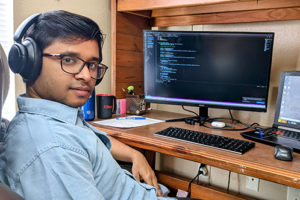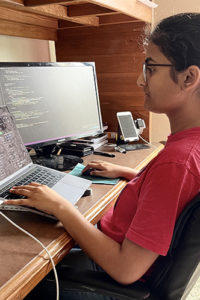The Center for Research & Development in Dual Language & Literacy Acquisition (CRDLLA) and Education Leadership Research Center (ELRC) in the College of Education & Human Development (CEHD) at Texas A&M University have taken the first steps to automate the process of conducting classroom observations.

Sunil Komadan
The two research centers partnered with faculty and students from the College of Engineering to develop the foundations of what they expect will become an artificial intelligence (AI) system. The system would be capable of analyzing video of classroom instruction and evaluating it for pedagogical quality.
“Teachers usually receive little feedback from busy school leaders on their classroom instruction. However, the literature is clear on how important teacher instructional quality is for student academic success. Educators cannot improve without regular, consistent feedback on their teaching,” said Dr. Beverly Irby, Senior Associate Dean for Academic Affairs in CEHD.
“We have a validated pedagogical theory, model, and instrument that are grounded in best practices for bilingual/English as a second language (ESL) instruction. We already use these tools to evaluate teacher instruction in bilingual/ESL classrooms, but it must be done manually by trained human coders. That process is time and labor-intensive,” added Dr. Rafael Lara-Alecio, Regents’ Professor.

Aishwarya Teegulla
In 1994, CEHD professors Drs. Lara-Alecio and Richard Parker published their four-dimensional pedagogical theory and model that incorporate research-based practices and strategies for teaching emergent bilingual students in bilingual and ESL settings. The resulting classroom observation instrument tracks instructional events, teacher/student language usage, and other important pedagogical features. This observation instrument, plus hours of recorded videos of teacher instruction and archived human-coded data, will enable the development of the AI system.
Last spring, the centers collaborated with Dr. Hank Walker, Associate Dean for Graduate Studies in the College of Engineering, and a team of master’s engineering students who were completing capstone projects. The group explored how to apply AI to the language of instruction, one of the four domains of the pedagogical theory, and developed an initial proof of concept. The AI system algorithm was able to extract audio from the videos, process it and identify the language spoken. The model was able to identify English with 90% accuracy and Spanish with 78% accuracy.
Two students from the capstone team, Aishwarya Teegulla and Sunil Komadam, joined the centers as graduate assistants. They designed an initial data dashboard that displays the collected and analyzed results from the teacher observations.
Last semester, two new engineering student capstone teams examined the language of instruction in Chinese and English and how to determine the speaker (student or teacher).
